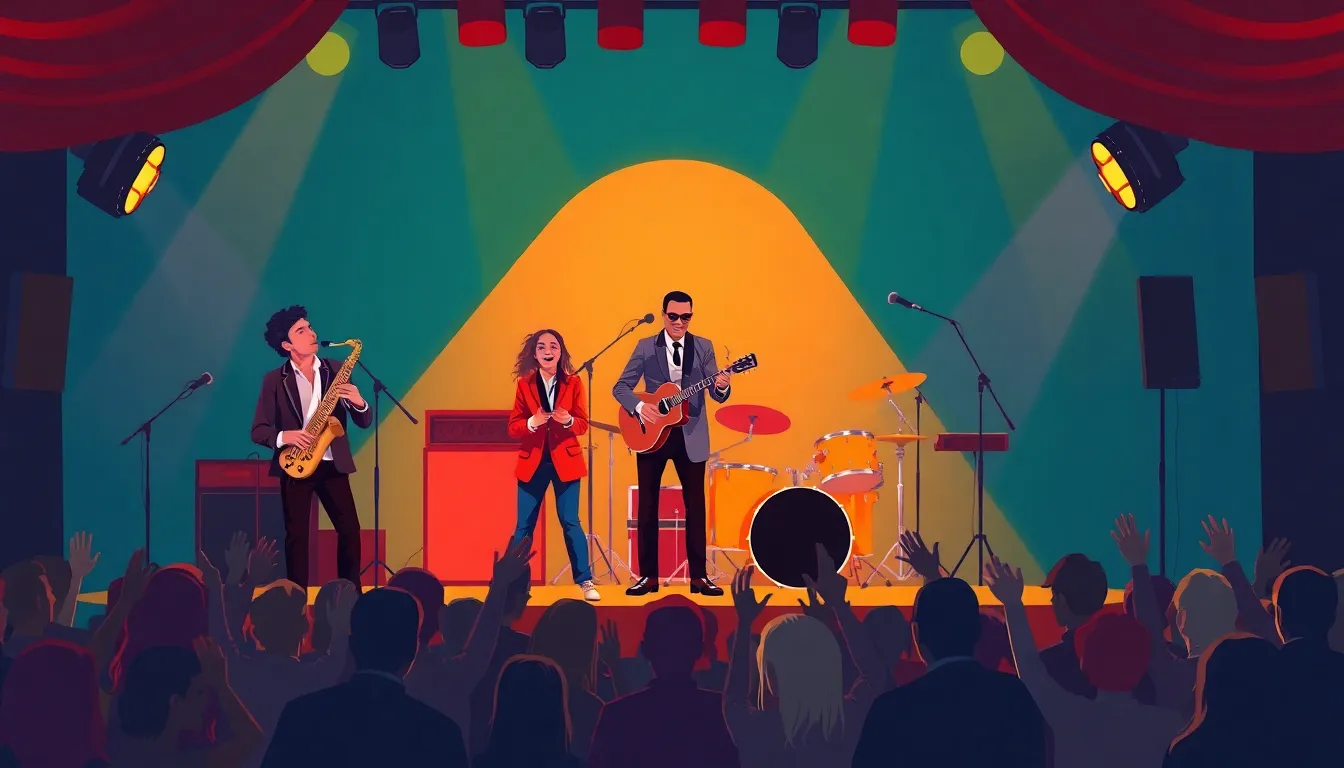In a world where playlists can make or break a mood, popular music reigns supreme. It’s the soundtrack to life’s most memorable moments, from epic road trips to quiet nights in. But what makes a song so catchy that it gets stuck in your head like that one time you tried to learn the Macarena?
From chart-topping hits to viral sensations, popular music is a cultural phenomenon that shapes trends and connects people across the globe. Whether you’re a die-hard fan of pop, rock, hip-hop, or country, the allure of popular music is undeniable. It’s not just entertainment; it’s a universal language that speaks to the heart and soul of humanity. So, plug in those earbuds and get ready to dive into the vibrant world of popular music—where every beat tells a story and every lyric resonates with life’s ups and downs.
Table of Contents
ToggleOverview of Popular Music
Popular music serves as a dynamic expression of contemporary culture. Various genres coexist, each offering distinct sounds and themes that resonate with diverse audiences. Pop, rock, hip-hop, and country represent some of the most influential genres in the music landscape today.
Listeners connect with pop music through its catchy hooks and relatable lyrics. Genres like rock often showcase raw emotion and storytelling, appealing to fans seeking depth. Hip-hop emphasizes rhythm and lyricism, reflecting societal issues and personal experiences. Country music frequently conveys stories of hardship, love, and resilience.
In 2023, streaming platforms like Spotify and Apple Music dominate music consumption. Statistics indicate that over 400 million subscribers utilize these services, enabling artists to reach global audiences instantly. Live performances also maintain significance, with some artists drawing crowds of tens of thousands at festivals and concerts.
Cultural diversity enriches popular music, allowing for the fusion of different styles. Collaborations between artists from various backgrounds frequently result in innovative sounds. For example, Latin pop has gained immense popularity, featuring artists like Bad Bunny and J Balvin who blend traditional rhythms with modern influences.
Music’s impact transcends entertainment, influencing fashion, trends, and social movements. Artists often become cultural icons, representing the values and aspirations of their fans. The climactic interplay of lyrics, melody, and production brings communities together, creating shared experiences that transcend geographical boundaries.
By examining the evolution of popular music, one reveals its adaptability in a world of rapid change. Each era introduces new themes and sounds, ensuring that music continues to resonate with generations. It’s essential to recognize popular music not just as an art form but as a driving force in shaping contemporary society.
Historical Development

Popular music has undergone significant shifts throughout history, influenced by social, cultural, and technological changes. These developments highlight the genre’s dynamic nature, allowing it to adapt and thrive.
Early Influences
The roots of popular music trace back to folk traditions and classical influences. Spirituals and blues laid the groundwork for many contemporary styles. Jazz emerged in the early 20th century, blending African rhythms with European musical structures. Swing and big band music later captured the public’s imagination, creating a lively, communal atmosphere.
Evolution Through Decades
During the 1950s, rock ‘n’ roll revolutionized music, combining rhythm and blues with country. Artists like Elvis Presley became household names. The 1960s further transformed the landscape, with the rise of the British Invasion and counterculture movements. By the 1970s, disco, punk, and funk took center stage, reflecting diverse social sentiments. The following decades saw the emergence of hip-hop and electronic music, fostering new artistic expressions. Popular music consistently reflects societal shifts and cultural exchanges, showcasing its continuous evolution.
Genres of Popular Music
Popular music encompasses a variety of genres that resonate with diverse audiences. Each genre contributes uniquely to the cultural landscape.
Pop
Pop music dominates the charts and appeals broadly to all age groups. Known for its catchy hooks and relatable lyrics, artists like Taylor Swift and Ed Sheeran exemplify its commercial success. Melodies often incorporate influences from different genres, ensuring widespread appeal. Themes in pop lyrics revolve around love, relationships, and self-empowerment. The genre’s accessibility makes it a staple in playlists worldwide.
Rock
Rock music emerged as a powerful voice for rebellion and expression. Iconic bands like The Beatles and Led Zeppelin shaped its evolution, blending emotional storytelling with innovative instrumentals. Guitar riffs and strong beats define its sound, which often reflects societal issues. Subgenres like punk and alternative rock cater to niche audiences, while maintaining broad recognition. Rock’s legacy continues through contemporary artists who draw from its rich history.
Hip-Hop
Hip-hop stands as a dynamic cultural movement founded on rhythm and lyricism. Artists like Kendrick Lamar and Nicki Minaj showcase the genre’s storytelling prowess and social commentary. Beats often incorporate samples from other genres, creating a unique soundscape. The genre serves as an outlet for personal and cultural experiences, addressing themes like inequality and resilience. Its influence permeates fashion, language, and art, reinforcing its significance in popular culture.
Electronic
Electronic music transforms sound through digital production and innovative technology. Genres like house, techno, and dubstep highlight music’s evolution in nightclub and festival settings. Artists such as Calvin Harris and Deadmau5 lead the scene, pushing boundaries with creativity. Beat drops and synth sounds energize crowds, making electronic music a party favorite. The genre’s global reach thrives through streaming platforms, connecting audiences from various backgrounds.
The Impact of Technology
Technology significantly alters how people access and experience popular music. Streaming services and social media platforms play pivotal roles in this transformation.
Streaming Services
Streaming services revolutionize music consumption, shifting away from traditional purchasing methods. Over 400 million users subscribe to platforms like Spotify and Apple Music, allowing instant access to vast libraries of songs. These services offer personalized playlists driven by algorithms, ensuring listeners discover new music tailored to their tastes. Artists benefit from increased exposure, granting them the opportunity to reach global audiences without the constraints of physical media. Additionally, data analytics provided by these platforms enable musicians to understand audience engagement, refining their marketing strategies.
Social Media
Social media platforms amplify the reach of popular music, enhancing artist engagement with fans. Musicians utilize platforms like Instagram, Twitter, and TikTok to share snippets of their work, generating buzz and creating viral moments. These channels enable fans to connect directly with artists, fostering a sense of community and participation in their creative journey. User-generated content often shapes music trends, as challenges and dance routines encourage widespread sharing. By harnessing social media feedback, artists refine their styles and address their audiences directly, ensuring their music resonates in an ever-evolving landscape.
Cultural Significance
Popular music serves as a reflection of society and a driver of change. It shapes cultural norms and influences public opinion on various issues.
Influence on Society
Music often acts as a catalyst for movements. Protest songs have documented social struggles, inspiring action and solidarity. Notable examples include “Fight the Power” by Public Enemy, which addresses racial inequality. Another influence comes from artists like Beyoncé, who promotes empowerment and social justice in her tracks. The rapid spread of music through social media amplifies these messages, making them accessible to wider audiences. Soundtracks frequently accompany major events, enhancing collective experiences such as celebrations or mourning.
Representation and Diversity
Diverse voices in popular music enhance cultural representation. Artists from different backgrounds showcase unique narratives, enriching the music landscape. Latin pop’s rise illustrates this fusion, with stars like Bad Bunny breaking charts worldwide. Female artists are increasingly taking center stage, emphasizing gender equality, while LGBTQ+ representation enhances visibility and acceptance. Genres like hip-hop and country draw from varied cultural roots, creating a tapestry of sounds and stories. Each artist contributes to a larger dialogue about identity, promoting understanding and inclusivity. The blending of styles invites new collaborations, pushing the boundaries of what music can express.
Popular music’s influence extends far beyond mere entertainment. It serves as a powerful medium for cultural expression and connection. As genres evolve and merge, they reflect the diverse experiences of society, showcasing the richness of human emotion and storytelling.
The rise of technology has transformed how music is consumed and shared, allowing artists to reach audiences worldwide and fostering innovative collaborations. This dynamic landscape ensures that popular music continues to resonate deeply with listeners, shaping trends and inspiring social change.
As it adapts to the times, popular music remains a vital part of our lives, capturing the essence of contemporary culture and offering a soundtrack to our shared experiences.



